| dc.description.abstract | Inclusive education denotes an educational. system in which a pupil with a disability unconditionally belonging to and having full membership of a regular classroom in a regular school and its community. The purpose of the study was to investigate the factors that influence the academic performance of visually impaired learners in Katulani Sub-county, Kitui County. The study was guided by a correlational research design since the intention was to examine the degree of relationship between fours elected independent variables and academic performance of learners who were visually impaired. The target population was 1,695 composed of 1,345 pupils, 300 teachers and 50 parents .A sample of 170 was proportionately and randomly selected• from the target population. A questionnaire was used to collect data from the learners and teachers, while an interview schedule was used to solicit data from the parents. The researcher carried out a pilot study on the two instruments using subjects from four primary schools in Katulani Sub-County. The purpose of the pilot study was to ensure that the instruments were valid and reliable for data collection. neither the schools nor the subjects drawn from those respective schools were used in the main study. Collected data was then sorted out for completeness, coded and then fed into a computer for statistical analysis, using IBM SPSS version 23software. Both descriptive statistics and inferential statistics, such as correlation coefficient and multiple regression were used in the analysis. After interpretation of the data, it was concluded that:-Thl approaches used by teachers in teaching VI learners influence these learners academic performance to a great extent. This approach includes group discussion, tutorial/remedial teaching and modification the curriculum. Most of the teachers do not use three-dimensional objects in their teaching because of lack of enough time attributed to lack of enough teachers. There are inadequate materials to make the realia, which affects the teachers' attitude towards their use since it required them to take a lot of time to prepare these resources. This had an effect on the academic performance. The major social-cultural factors which influence VI learners academic performance includes, lack of positive attitudes towards VI learners in an inclusive setting by parents or teachers and the fact that VI learners are not given favourable learning environment by their parents. The major curriculum gap towards learning of VI learners in an inclusive setting is that there is lack of clear policy guidelines and legal status on Special Needs Education provisions and the rigid assessment procedures based on mean score competition, which does not consider VI learners. Consequently, it was recommended that the teachers should improve on their teaching approaches to accommodate the learners with visual impairment. Schools should be encouraged to provide enough teaching resources to take care of the VI learners. The government should design a special curriculum to favour VI learners as there is a curriculum gap as revealed by this study. | en_US |

